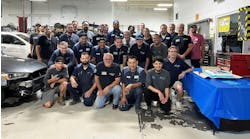Metal repair pitfalls can be cured with concentration, anticipation and most of all, training.
Mike West remembers working on the rear suspension of a Cadillac a few years ago.
"I compressed the coil spring with a spring compressor, the threaded type," says West, owner of Southtowne Auto Rebuild in Seattle, Wash. "When I released and lowered the lower control arm, the spring began to tip and fall out. I thought to myself, 'No big deal. The spring won't be damaged by letting it fall.'
"Well, I was right. It didn't hurt the spring, but it sure hurt me. When the spring hit the floor, the compressor popped off and the spring released, bounced off the floor, and hit me in the face, bringing me to my knees. The compressor came up with the spring and threaded my forehead and lips. Real pretty."
Fortunately, West says, you can't hurt an Irishman by hitting him in the head with an automobile spring. "The cuts healed. I was extremely lucky. But complacency on my part resulted in a dangerous situation. This work requires focus and anticipation of what might go wrong. I should have anticipated the problem and used a simple piece of mechanic's wire to keep the spring from falling."
Complacency, carelessness, laziness, cutting corners-any of these can result in metal shop nightmares-nightmares that may manifest themselves immediately, such as in West's case, or later, after the car has been delivered to the customer. Either way, they're costly in ways that may affect the bottom line, and often in terms of human suffering.
The best way to avoid metal shop pitfalls, of course, is through education, according to Bruce Evenstad, vocational instructor at Bellingham Technical College in Bellingham, Wash.
Evenstad says it's important for all technicians to keep their skills and training up to date. "Training is probably the biggest shortcoming in the shop," he says, "followed by laziness, or cutting corners to get the job done faster." He recommends having everyone in the shop I-CAR trained, followed by ASE Certification.Like most endeavors in life, it comes down to knowledge-and application of that knowledge.
Dangerous Repairs
Sometimes the danger is to the vehicle owner, not to the repair technician. An improperly repaired vehicle that is delivered to the customer may be an accident-or a lawsuit-waiting to happen. A mistake in structural repair can compromise crush zones. The result could be movement toward, rather than away from, occupants. It can also affect air bag deployment.Improper sectioning and improper welding and misaligned structural components also can lead to a structurally weakened vehicle. "Not properly straightening vehicles and bringing them back to
factory specs is a major failing," according to Evenstad. That's why, he says, it's essential that everyone in the shop has access to the factory OEM repair manual and repair procedures for all vehicles. "And shop management needs to make sure everybody follows those procedures. It's essential that the car is straightened correctly before the new or used parts are welded on the vehicle."
Of course, those parts must be properly installed too: Loose bolts or improperly torqued suspension fasteners are extremely dangerous.Be Clear on Glass
An improperly installed replacement windshield is particularly dangerous. It's a danger in and of itself, and can affect air bag function in a collision. Many dash-mounted air bags depend on the windshield to deflect the airbag into the passenger compartment. If the windshield breaks loose, the air bag takes the path of least resistance and deploys out of the car, instead of where it was designed to go, toward the passengers.Says West, "Make sure you know the proper recommended glass replacement procedures. If you don't know them, educate yourself about them, or give the job to someone that you can trust to do it right."



